Menus
- Track test: a higher R
- Discovery
- In the saddle
- What changes
- Discovery: What is this stuff ?
- Braking … and the rest.
- At the breaker
- Convenient ?
- Profitable ?
Track test: a higher R
The Triumph sports range now begins and ends at 675 cc since the disappearance of the Daytona 955 (which was not a true hypersport and which is no longer in the catalog). For those who still want more, there is the 675 R, supposed to do better than very well. It’s clear ? Not really, so let’s go into more detail.

After a few years of searching for itself, Triumph has given itself a course and is sticking to it. Concretely this means that today the English range does not include any more than bi or 3 cylinders, emblematic mechanics with the character in hardened steel. (see the "on your mark" section with the Triumph analysis). In fact, after trying to imitate the Japanese with bland 4-cylinder, already outdated upon their release, the Hinckley manufacturer hit hard with its three-cylinder. Marketed in 2006, it laid new foundations for the hyper sport segment. Taking advantage of a displacement equivalent specific to this category, it cubed 675 cm3, in the same way that Ducati once took advantage of its twin cylinder to reach 750 cm3, where the 4 legs are limited to 600. But above all, when faced with 600 that only worked at extreme revs, the Triumph offered all the (good) character and availability of the triple. It also took advantage of the narrowness of its mechanics to display extraordinary compactness and “breathtaking” lines, meaning by that, very aerodynamic..

Discovery
Appeared in 2006, the 675 has never been in lace. She is a pure athlete whose shark look says a lot about her intentions to do battle. After three years of existence, the English firm gave it a little facelift … without reneging on the initial specifications. At Triumph we understood: if the recipe is good, it should not be changed. We even understood everything, since, helping success, what changes the most about this bike … It’s the price! Think that it only cost 10,350 € when it was released! If we compare the evolution of its price with that of salaries, we are not winners … But never mind, Triumph had undoubtedly made a big effort at its launch to establish itself in this category. , hotly contested. A successful bet. Aesthetically, the 2009, still in production, is distinguished by a new sharper front end, but overall, the evolutions are cosmetic.
In the saddle
As you might expect, the initial contact is radical. You just have to get on the bike to understand who you are dealing with. High saddle, tilted forward position, very supportive on the wrists, we quickly give thanks! The size is tiny, but the shorter legs will find it difficult to put their feet on the ground, because of this very high rear. You also have to bend your neck copiously to see the road. In short in town or on long journeys, this bike quickly becomes hell. It is a track woman, period! The new dashboard that we have before our eyes reveals a red zone at 15,000 rpm against 14,000 on the first version. On-board computer, shiftlight, the functions are the same: average and instantaneous consumption, maximum speed, stopwatch, etc….

What changes
Undoubtedly this "R" has an air of deja vu precisely. Let’s talk here about evolution rather than revolution. For the manufacturer, there was no question of calling into question the approval and reliability of the 675 by seeking to make it gain a few additional horses. What’s the point ? The Daytona is perfectly at the level of the Japanese competition. With its 125 announced horses, it beat the pawn of its rivals on the ground of the recoveries. The delicate balance between reliability, performance and pleasure is undoubtedly close to the optimum here. It would be dangerous to deviate from it … Unless the MV pushes her too hard. But in the meantime, Triumph is saving money by only retouching accessories. Thus, the Kayaba fork and shock absorber give way to more high-end Ohlins equipment..
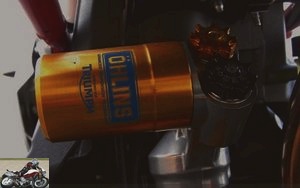
The 43mm inverted fork (41 for the Kayaba) adjusts for compression on the top of the left leg and rebound on the top of the right. No need to lower. Its tubes receive an anti-friction coating, titanium nitride, to improve its sensitivity to small impacts. The Ar shock absorber is a TTX, which therefore uses twin-tube technology, which is ultimately not that new (EMC uses it, Bitubo too, etc.). But either, this Ohlins benefits from all the house know-how, except that in this version, it does not gratify you with the hydraulic spring preload adjustment. Aesthetes will console themselves by thinking that it is less heavy.
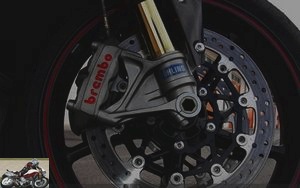
When it comes to braking, the Nissin calipers are replaced by Brembo, also monobloc, offering a better feeling, thanks to the brake master cylinder which goes from 19 to 18 mm, which reduces the effort on the handle.
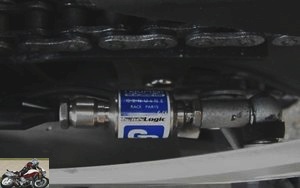
We also notice the presence of a shifter to change gears without cutting the gas or disengaging. Finally, aesthetically we note a rear loop painted in red and a net of the same color on the edge of the rims. To this are added a few carbon touches inside the fairing, on the exhaust thermal protection, the front mudguard and the tiny rear wheel arch .. to give a party R, no doubt..
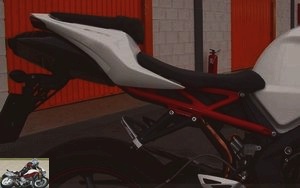
Discovery: What is this stuff ?
A push on the starter and the three legs makes hear a sweet melody, which comes out through the exhaust still located under the saddle. The 675 Triumph has always made me dream and my first contact with it left me with lasting memories. It was during a Bridgestone presentation (BT 003 RS). The mixed weather, wet greasy asphalt, on a route that I did not know, made me uncomfortable. I watched my colleagues having fun with the motorcycles, unable to pick up the pace over the first 2 sessions. Then suddenly the third arrives and the Triumph Daytona is released. I jump on the windfall and ask my eminent colleague, Eric Maurice, to teach me the science of trajectories, I feel so lost. I go after him and after 2 turns, it’s like a revelation. " What is that thing ? I thought. It goes where you look, it comes out of turns like a ball, there is torque, it brakes incredibly well and it swallows the big curves without flinching … instantly I take the rhythm of my colleagues and cling to their basques.
Over the laps the herd accelerates and Eric, still recovering from a recent fall, drops out of the peloton. Remembering his promise then he turns to locate me. Placed in ambush behind him, I take the opportunity to overtake him, sure that he will accelerate and pass me back … But that neni, the master (then reduced let us recall him) remains behind … will just tell me "for the trajectories … it’s going to be fine I think, you don’t need me!" ". Indeed, this incredible 675 gave me wings. The benchmark that instantly came to mind was the phenomenal Ducati 749 “R”. The real one, the racing one, with the short stroke engine and all titanium. Another “trick”, sold € 20,000 in 2004. But let’s come back to our Triumph, whose R does not have all the meaning that it has at Ducati. Here the differences with the base model are much smaller, as much in price as in quantity or in quality. Are they accessible to the common bikers so far?
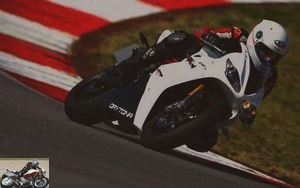
Braking … and the rest.
Because unlike the Street triple, which becomes triple R receives real good suspensions and radial brakes, the base Daytona is already very well endowed. Take braking for example. With its Nissin monobloc radial brakes, and braided hoses, it already has excellent braking, combining feeling and power. The diameter of the discs (308 mm) remains the same on both versions. Ditto for its Kayaba suspensions adjustable in compression and rebound, slow and fast, which make this 675 a "tool" on track, if not a model of comfort. Precise, light (again, normal or R, they are strictly the same weight, namely 190 kg with full), the 675 is placed and swings with great ease. Note in passing that the rims also remain identical. There is no advantage here with lighter forged wheels, to improve handling for example. Real pilots will appreciate the combination of more incisive braking and the more sensitive front fork, which makes it possible to delay braking and enter harder in curves. On wrinkled circuits, the R will be more comfortable, as long as its suspensions are perfectly adjusted. Because the slightest change results in less playful behavior and then we no longer find the wonder we have known. In short, to really make a difference, it will be necessary to be good, and even very good, even excellent, or to have the two versions side by side, which was never our case! Let’s not forget the shifter, which allows you to change the throttle grip ratios fully screwed in, which is very pleasant on the track. Let’s recognize there an undeniable plus.

At the breaker
Normal or R we always appreciate the engine of the Triumph Daytona. Logical, it’s the same as we just said! If it is as powerful as those of the 600 4 cylinders, and even a little more when one checks on the bench, it offers much more torque at lower revs, but a little less extension in return. Its red zone at 15,000 rpm starts at 1,000 to 1,500 rpm rather than its rivals. In fact, we are often surprised by the switch, especially since the dashboard on a black background is not the most readable and with the shifter, we quickly get stuck in the bubble and take for a pilot.
A real joy ! It must be said that the "buttocks in the air" position encourages you to the dab position, knees tight on the tiny tank and elbow tucked in. The narrowness is good, even if in terms of protection we are far from optimal. For the practical aspects, moreover, we refer you to the excellent test of the 675, because in this area, nothing has changed.
Convenient ?
No, certainly not! The saddle is just made to sit on, you won’t put anything under it. The driving position is tiring, as we have already said. Installed on a folding seat, the passenger will have the feeling of being seated on an ejection seat. But let’s recognize that this is the case on many sports. Finally, apart from its multifunction dashboard, the 675 makes no practical concessions, or even for comfort. The spirit of the Ducati hypersport is not far off, but with more engine versatility thanks to the additional cylinder … It is both rustic and functional, entirely dedicated to the pleasure of driving. Tourists and walkers go your way…
Profitable ?
Offered at € 13,390, i.e. 400 more than when it was released, the Daytona 675 R is billed € 1,800 more than the basic version (at € 11,590 therefore). Considering the equipment, there is no theft, but in fact this price places it far from its rivals which are all at € 12,000, including the new MV Agusta. The only exception is the Yamaha R6 at € 12,500. One thing is certain, sold € 400 less than its rivals, the base Daytona is a bargain not to be missed. For the most sophisticated, and the most fortunate, there is no doubt that the additional € 1,800 is justified. With the 675 they already have a real bomb and with the R they will also have "a beautiful object", with beautiful material that will appeal to even MV owners..
Strong points
- Lightness, agility, ease.
- The extraordinary three-cylinder
- The shifter
- Braking
- Finishing
- Piloting pleasure
Weak points
- The discomfort of the driving position in town and on the road
- Sensitivity to suspension settings
- The dashboard on black background
- The price that keeps rising
- The absence of ABS, even as an option
Competitors: Ducati 848, Honda 600 CBR,
Suzuki GSX-R 600, Triumph Daytona 675, Yamaha R6
Datasheet
| Reader essays on
the Testing forum
Related articles
-
Suzuki GSX-R 600 motorcycle test
Little Queen Revamped this year, the 600 GSXR follows in the footsteps of its big sister 750 cm3 from which it borrows the dress and even all the…
-
Triumph Bonneville Speedmaster test
In-line twin, 1200 cc, 77 hp at 6100 rpm, 106 Nm at 4000 rpm, 245.5 kilos dry, from € 14,350 A more modern proposition in the 1200 cruiser segment… Are…
-
Honda CRF 250 L motorcycle test
A little trail that sparkles The great Escape You don’t like small cars? So be sure to read this article! Because after discovering this new Honda, you…
-
Kawasaki ZX6R 636 motorcycle test
The bomb The Kawasaki ZX-6R, which became ZX-6R 636 in 2001, has long been one of the most versatile sports cars in its category. In 2002, it has…
-
To put in all hands !! Yes, I know, I am a little too biased to write this essay considering my visceral attachment to the English brand, but I will do…
-
KTM 890 Duke R motorcycle test
R for Revolution, the circle has come full circle Parallel twin of 890 cm3, 121 hp, 99 Nm, 166 kg dry, 11,900 euros We no longer present the KTM Duke,…
-
Triumph Legend 900 motorcycle test
Biker test: Evelyne I got married with a biker at the age 40 years old. Wishing to share the passion of my companion, I pass my motorcycle license at the…
-
1,800-kilometer test Unveiled in 2004, the Honda CBF 600 offers a basic motorcycle, versatile and accessible to young drivers. In 2008, it benefited from…
-
Ducati 1098 motorcycle test – 160 hp in free version
There are times in a biker life where the emotional strikes, in the heart ! I remember when the 916 was released : what a slap! A stroke of genius signed…
-
Suzuki GSX-R 1000 motorcycle test
A friend who wants you well First appearing in 2000, the GSXR 1000 will quickly establish itself as a sporting stallion for a long time. But in the face…